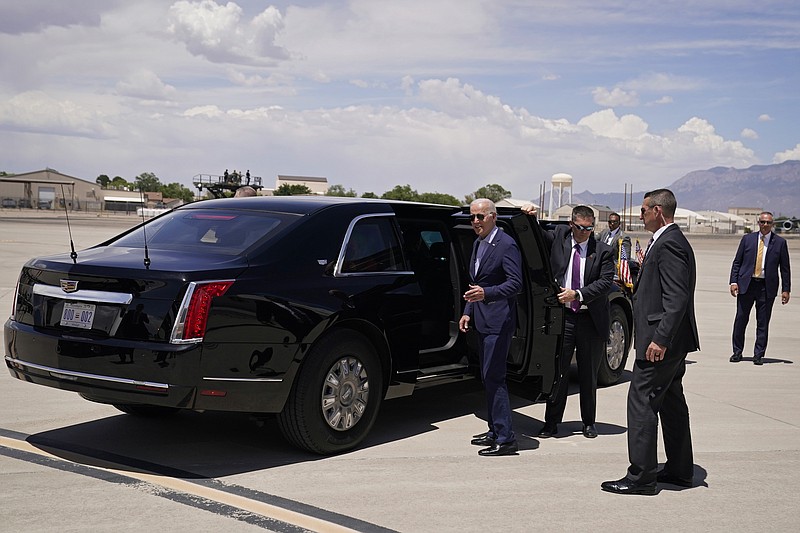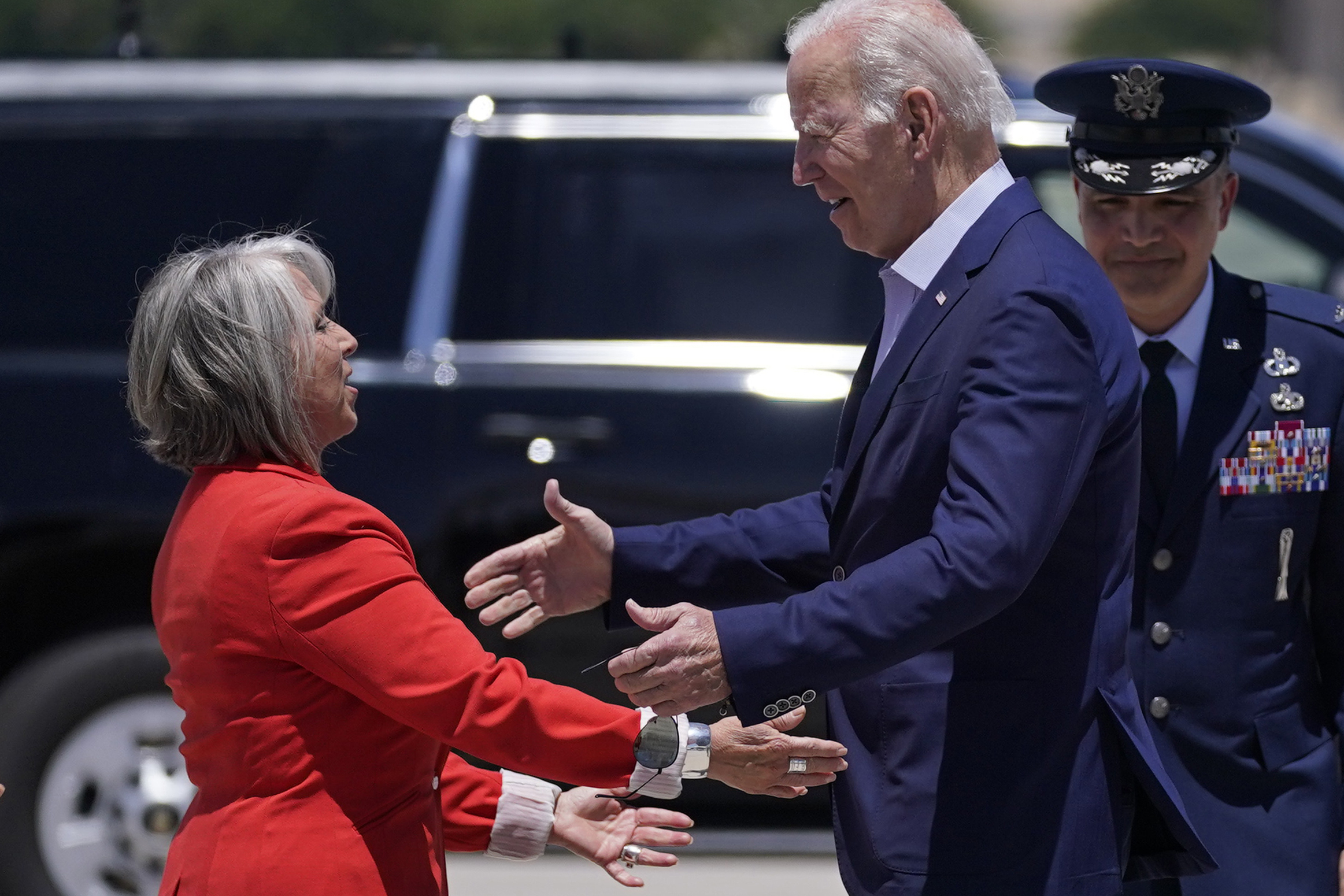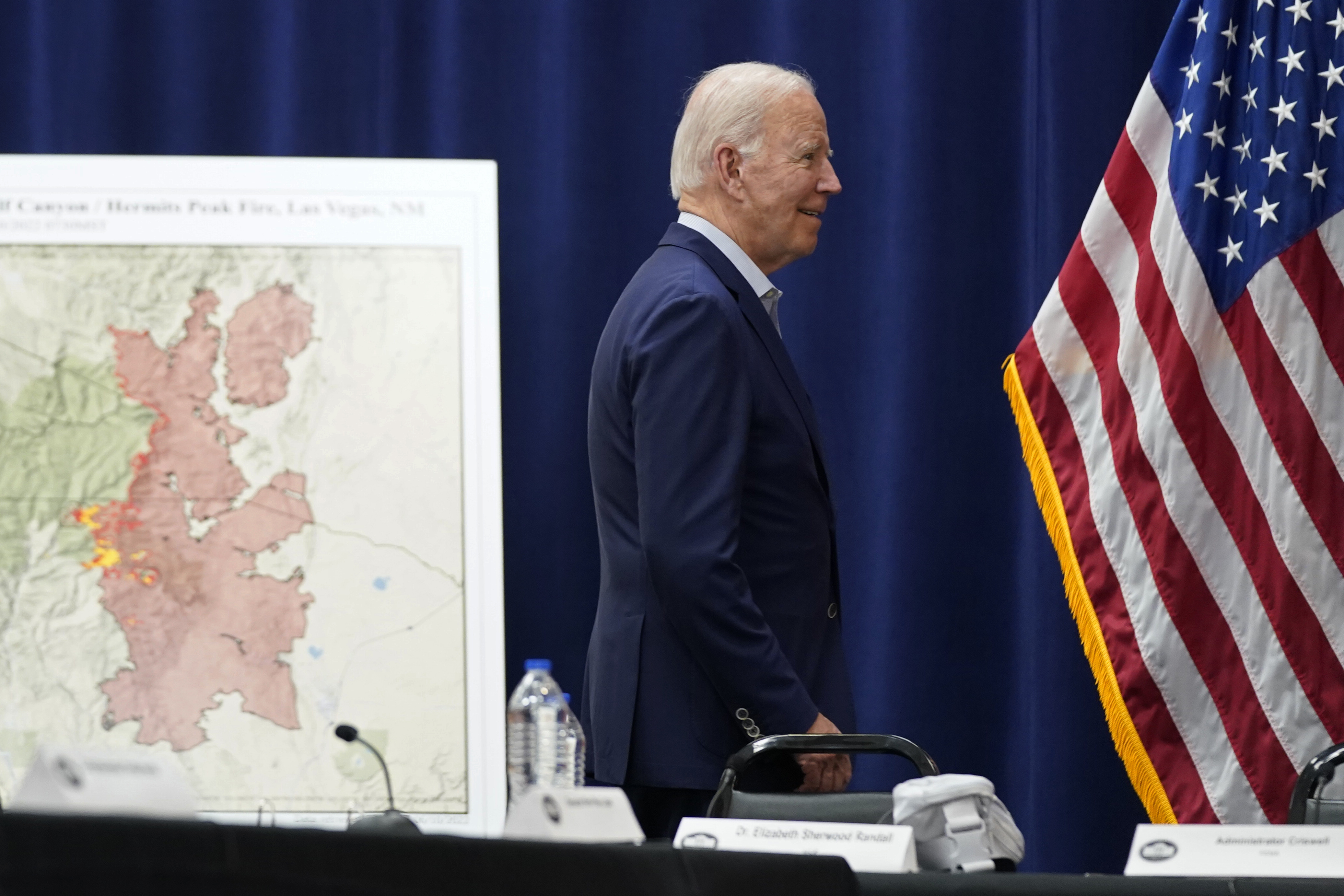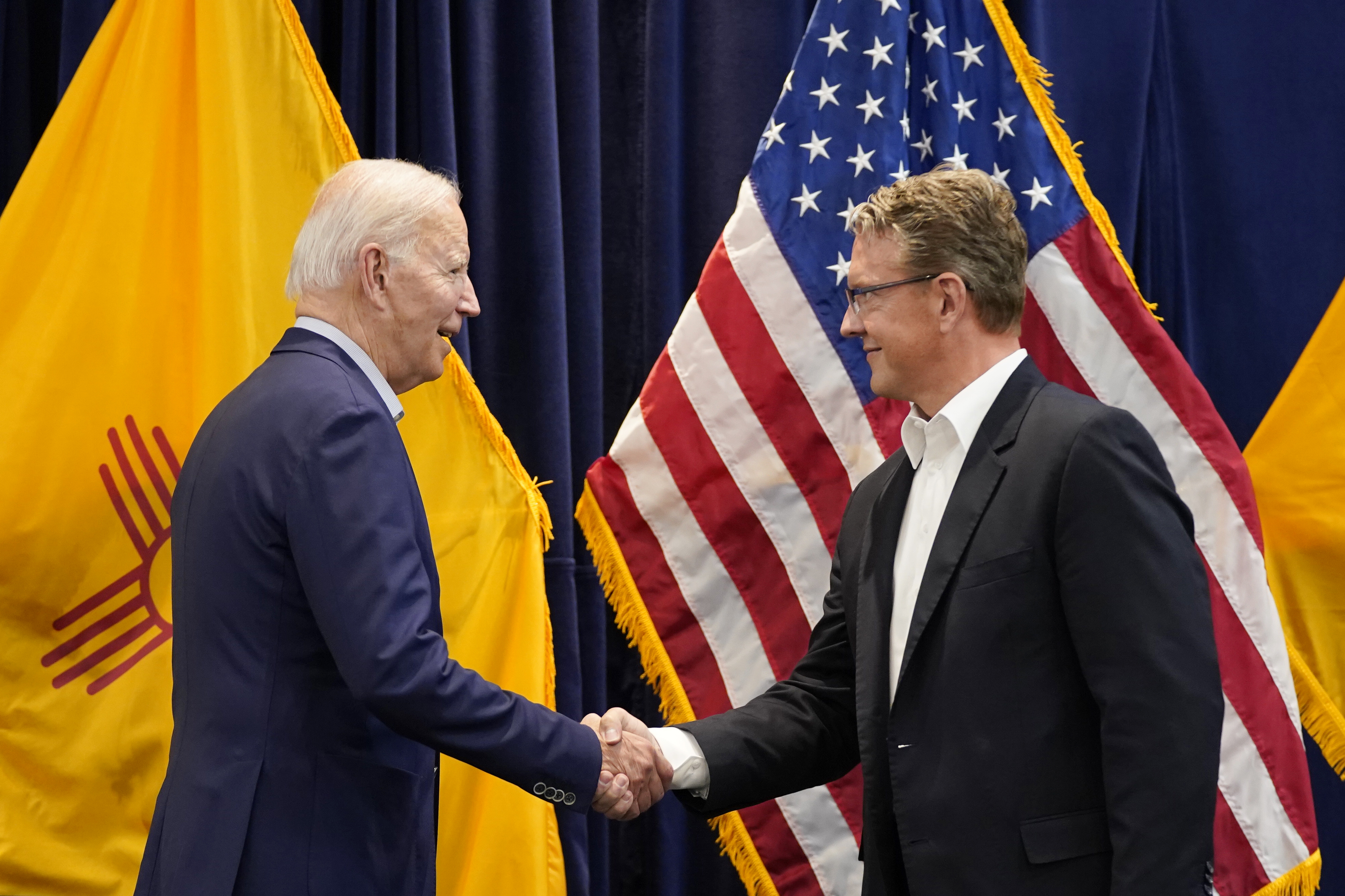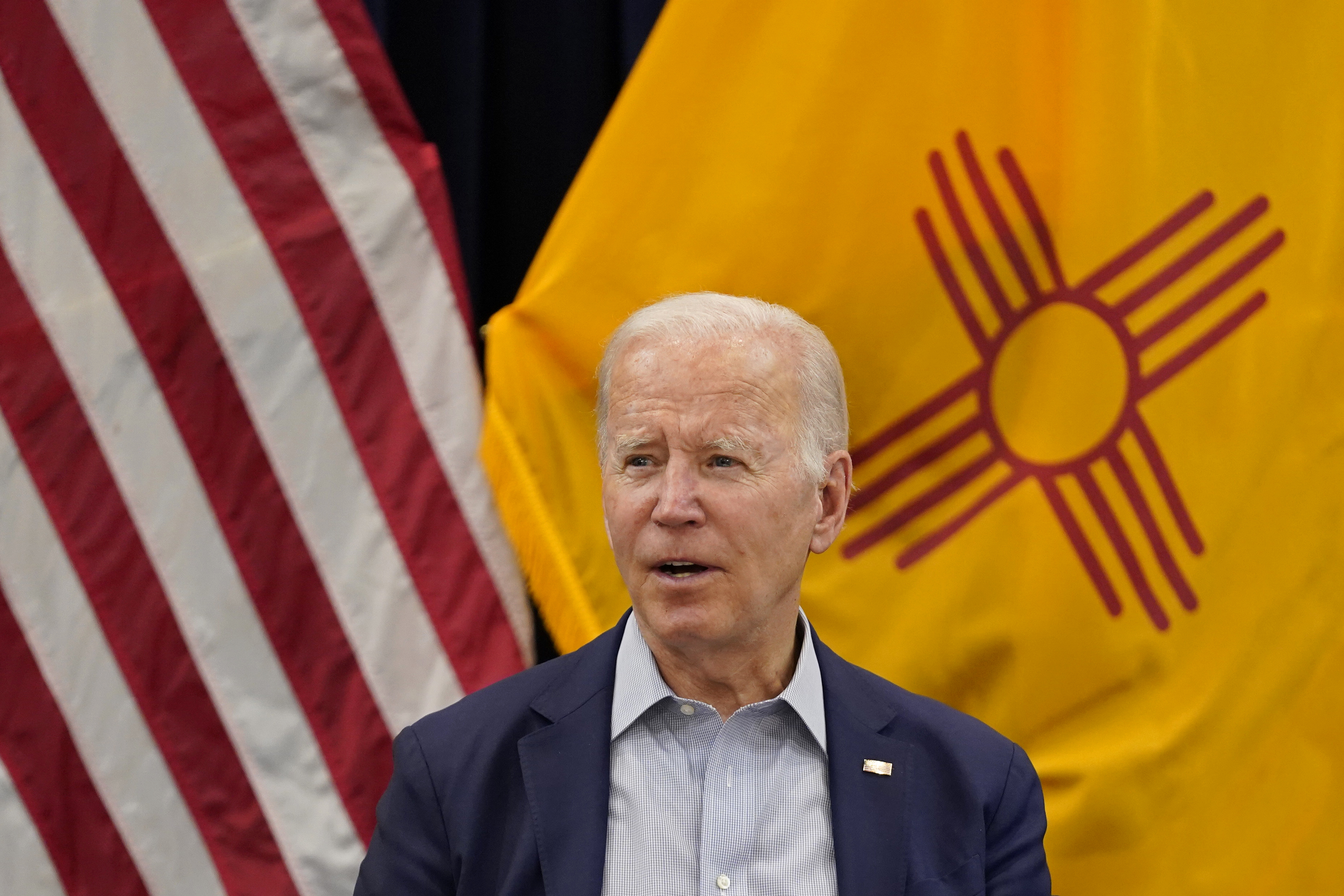SANTA FE, N.M. -- President Joe Biden said Saturday he was escalating federal assistance for New Mexico as it faces its largest wildfire in recorded state history.
The fire began with prescribed burns that were set by the U.S. Forest Service, a standard practice that's intended to clear out combustible underbrush. However, the burns spread out of control, destroying hundreds of homes across 500 square miles since early April, according to federal officials.
"We need to be sure this doesn't happen again," Biden said during a visit to an emergency operations center in Santa Fe, where he met with local, state and federal officials. He was returning to Washington from Los Angeles, where he had attended the Summit of the Americas.
The president said the federal government would cover the full cost of the emergency response and debris removal, a responsibility that was previously shared with the state government.
New Mexico Gov. Michelle Lujan Grisham told Biden that "your administration has leaned in from the very beginning" and that "we need the federal government to keep accepting responsibility."
Biden said he also supports having Washington foot the bill for damages caused by the fire, but such a step would require congressional action.
Evacuations have displaced thousands of residents from rural villages with Spanish-colonial roots and high poverty rates, while causing untold environmental damage. Fear of flames is giving way to concern about erosion and mudslides in places where superheated fire penetrated soil and roots.
The blaze is the latest reminder of Biden's concern about wildfires, which are expected to worsen as climate change continues, and how they will strain resources needed to fight them.
"These fires are blinking 'code red' for our nation," Biden said last year after stops in Idaho and California. "They're gaining frequency and ferocity."
But the source of the current wildfire in New Mexico has also sparked anger.
A group of Mora County residents sued the U.S. Forest Service last week in an effort to obtain more information about the government's role.
The Forest Service sets roughly 4,500 prescribed burns each year nationwide, and Biden said the practice has been put on hold during an investigation.
Ralph Arellanes of Las Vegas, N.M., said many ranchers of modest means appear unlikely to receive compensation for uninsured cabins, barns and sheds that were razed by the fire.
"They've got their day job and their ranch and farm life. It's not like they have a big old house or hacienda -- it could be a very basic home, may or may not have running water," said Arellanes, a former wildland firefighter and chairman for a confederation of Hispanic community advocacy groups. "They use it to stay there to feed and water the cattle on the weekend. Or maybe they have a camper. But a lot of that got burned."
The Federal Emergency Management Agency has approved at least 900 disaster relief claims worth more than $3 million for individuals and households.
On Thursday, the Biden administration extended eligible financial relief to the repair of water facilities, irrigation ditches, bridges and roads. Proposed legislation from U.S. Rep. Teresa Leger Fernandez, D-N.M., would offer full compensation for nearly all lost property and income linked to the wildfire.
Jennifer Carbajal says she was evacuated twice from the impending wildfire at a shared family home at Pandaries in the foothills of the Sangre de Cristo Mountains. The house survived while about 50 neighboring homes burned along with the tanks that feed the municipal water system, leaving no local supply of potable water without truck deliveries.
"There is no long-term plan right now for water infrastructure in northern New Mexico," Carbajal said.
She said matters are worse in many hardscrabble communities across fire-scarred Mora County, where the median household income is roughly $28,000 -- less than half the national average.
"They barter a lot and really have never had to rely on external resources," she said. "The whole idea of applying for a loan [from FEMA] is an immediate turnoff for the majority of that population."
Jaclyn Rothenberg, a spokeswoman for FEMA, said the agency had more than 400 personnel in the state to work with residents and help them seek federal assistance.
George Fernandez of Las Vegas, N.M., says his family is unlikely to be compensated for an uninsured, fire-gutted house in the remote Mineral Hills area, nor a companion cabin that was built by his grandparents nearly a century ago.
Fernandez said his brother had moved away from the house to a nursing home before the fire swept through -- making direct federal compensation unlikely under current rules because the house was no longer a primary residence.
"I think they should make accommodations for everybody who lost whatever they lost at face value," Fernandez said. "It would take a lot of money to accomplish that, but it was something they started and I think they should."
ALASKA BLAZE
Elsewhere, the largest documented wildfire burning through tundra in southwest Alaska was within miles of two Alaska Native villages, prompting officials Friday to urge residents to prepare for possible evacuation.
This came a day after dozens of elders and residents with health concerns voluntarily evacuated because of smoke from the nearby fire.
Officials on Friday put the communities of St. Mary's and Pitkas Point into "ready" status, meaning residents should gather important items they would want to have with them if they have to evacuate, said U.S. Bureau of Land Management Alaska Fire Service spokesperson Beth Ipsen by text. That would be followed by "set," or getting a go-bag ready and leaving if the "go" order is given.
The fire is consuming dry grass, alder and willow bushes on the largely treeless tundra as gusts of up to 30 mph are pushing the fire in the general direction of St. Mary's and Pitkas Point, Yup'ik subsistence communities with a combined population of about 700 people and about 10 miles apart.
More than 100 firefighters were expected to be battling the blaze by the weekend, Ipsen earlier said by phone.
The fire had not grown much since Thursday and was still estimated at 78 square miles. The northerly winds pushed the fire to within 5 miles of St. Mary's, officials said in a late Friday update.
Ipsen said she was not aware of any structures that have been lost.
Crews cleared brush and other fuel from a swath of land in the path of the flames, and air tankers dropped retardant between the line and St. Mary's as another buffer. Other aircraft had been dropping water on the fire until another fire broke out north of a nearby community, Mountain Village.
Climate change has played a role in this historic fire, said Rick Thoman, a climate specialist with the University of Alaska Fairbanks' International Arctic Research Center.
He said based on records from the Alaska Fire Service dating back to the 1940s, this is the largest documented wildfire in the lower Yukon River valley. There are much bigger fires recorded just 50 or 60 miles north of St. Mary's, but those burned in boreal forests.
The area where the tundra fire is burning, the Yukon-Kuskokwim Delta, lost its snowpack early this year, leaving grass and other vegetation longer to dry out. Coupled with the warmest period on record in the region recently, it provided for the perfect storm for this fire that was started by lightning on May 31.
"Climate change didn't cause the thunderstorm that sparked that fire, but it increased the likelihood that the ambient conditions would be receptive," Thoman said.
The southwest Alaska hub community of Bethel, about 100 miles southeast of St. Mary's, is the closest long-term weather station.
For the period covering the last week of May and the first week of June, Bethel had its warmest temperatures on record this year, 9 degrees Fahrenheit above its normal 48 degrees F, Thoman said.
About 80 village elders and others with health concerns were relocated to the Alaska National Guard Armory in Bethel on Thursday, said Jeremy Zidek, spokesperson for the Alaska Division of Homeland Security and Emergency Management.
Two companies that provide commuter air service in roadless western Alaska flew the passengers to Bethel.
One of those was Yute Commuter Services, which provided 12 flights out of St. Mary's on its planes that seat six, said Andrew Flagg, the company's station manager in Bethel.
On Friday, he said they were asked to deliver drinking water to the community so it could be given to the firefighters.
St. Mary's and Pitkas Point, which is at the confluence of the Andreafsky and Yukon rivers, are located about 450 miles west of Anchorage.
Information for this article was contributed by Mark Thiessen of The Associate Presss.
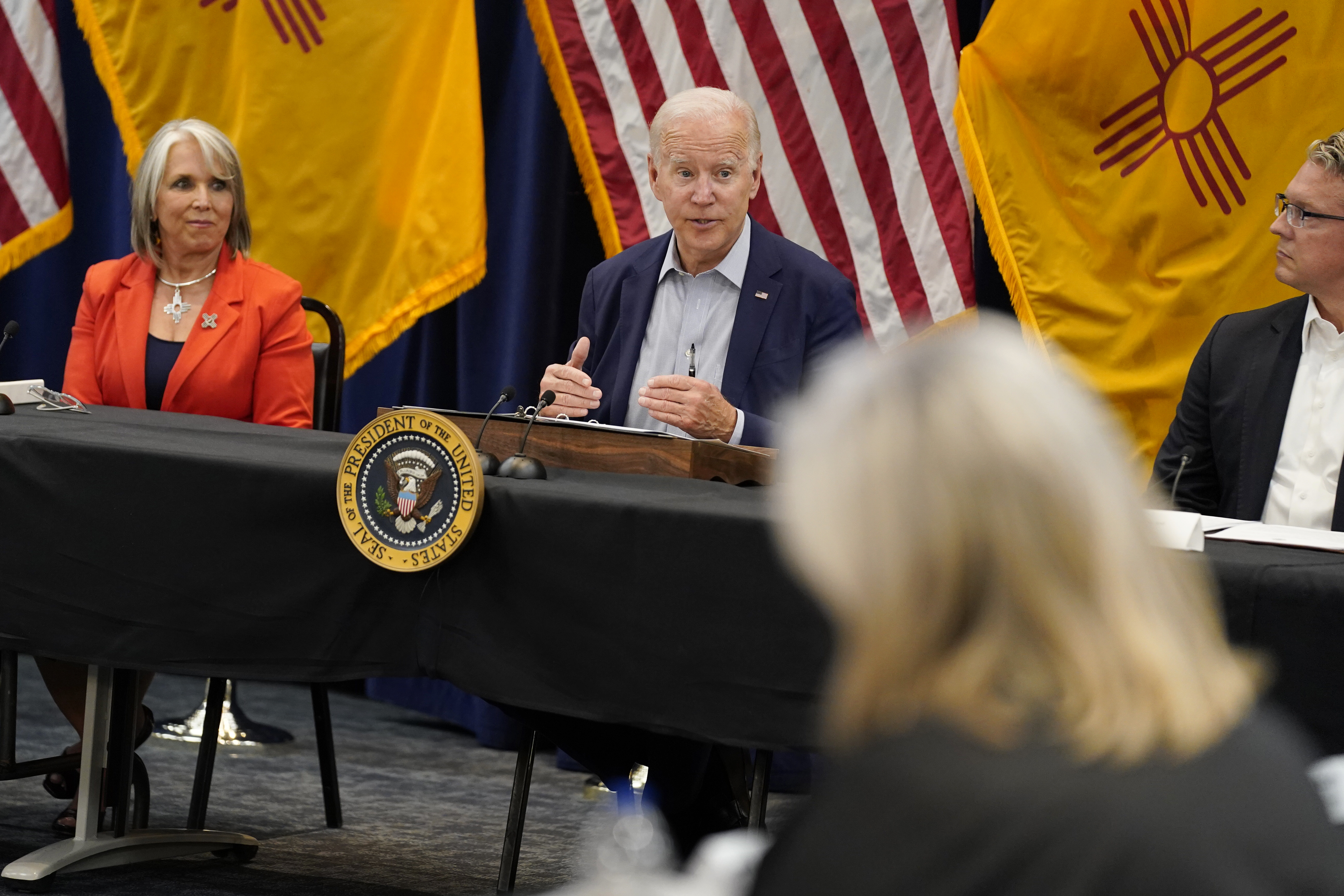 President Joe Biden, center, speaks during briefing on the New Mexico wildfires with New Mexico Gov. Michelle Lujan Grisham, left, and David Dye, New Mexico secretary of homeland security and emergency management, at the New Mexico State Emergency Operations Center, Saturday, June 11, 2022, in Santa Fe, N.M. (AP Photo/Evan Vucci)
President Joe Biden, center, speaks during briefing on the New Mexico wildfires with New Mexico Gov. Michelle Lujan Grisham, left, and David Dye, New Mexico secretary of homeland security and emergency management, at the New Mexico State Emergency Operations Center, Saturday, June 11, 2022, in Santa Fe, N.M. (AP Photo/Evan Vucci)Gallery: Biden visits New Mexico amid wildfires
